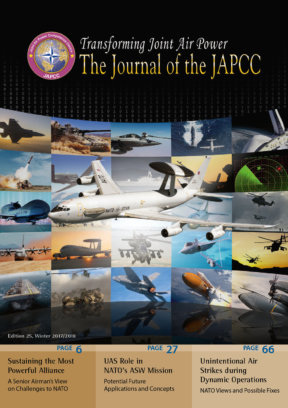Editorial
2017 was another fruitful year for the JAPCC. While we continued our core business as NATO’s catalyst for the improvement and transformation of Joint Air and Space Power; some significant projects were completed and many new interesting work strands were initiated. Our ongoing efforts to improve cooperation amongst NATO, EU and national air and space organizations continue to bear fruit, evidenced by expanding participation in our annual Think Tank Forum and Joint Air and Space Power Network Meeting. Our annual JAPCC Conference saw the highest turnout ever, hosting distinguished guests from the full range of political, military and industrial leadership. Finally, in an exciting turn of events, Greece revived its participation in the JAPCC this past summer, which again underlines our value to Allied nations.
The JAPCC Journal is one of the principal tools we use to fulfil our mission and it is my great pleasure to present the 25th edition. In the opening article JAPCC Director, General Tod Wolters shares his thoughts about the sustainment of the Alliance’s military power through an integrated joint warfighting capability in which a robust and credible air and space force will remain an important pillar. The General also suggests this will require multilateral solutions as well as exploring new capabilities to allow the Joint Commander to meet the challenges of the future multi-domain battlefield. In this regard, viable command and control in this multi-domain environment is relevant to explore. The two following articles therefore specifically expand on this subject, describing how the E-3A AWACS Final Life Time Extension Program may initially enable ‘Multi-Domain C2 (MDC2)’, and report on the results and implications of recent interoperability testing between AWACS and Allied Ground Surveillance (AGS) during Unified Vision 2016.
This Journal then moves into other relevant topics currently being dealt with, such as user requirements for a Future Battlefield Rotorcraft Capability, the interesting potential of Unmanned Aerial Systems (UAS) for use in Anti-Submarine Warfare, the importance of maritime rotary wing assets for naval and joint operations, the interoperability of air transport fleets in NATO, future options for Surface-Based Air and Missile Defence, and opportunities and risks of UAS miniaturization to include developments in Counter-UAS technology. Furthermore, EUROCONTROL offers an essay outlining the current challenges and solutions in civil-military Air Traffic Management to cope with the demanding requirements for military flight integration into a ‘Single European Sky’. Finally, one article deals with the critical subject of unintentional air strikes, touching upon several areas where military and civilian organizations could improve to prevent such incidents in the future.
Thank you for taking the time to read this edition of our Journal. I congratulate the authors on their contributions and I strongly encourage our readers to consider sharing your thoughts as you go forth and advocate for Air Power. The JAPCC team greatly appreciates your feedback and thoughts. Please visit our website at www.japcc.org, like us on LinkedIn or Facebook, or follow us on Twitter to tell us what you think.
Madelein Spit
Air Commodore, NE AF
Assistant Director








